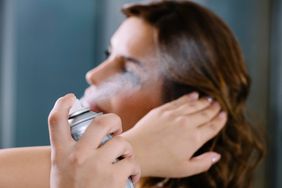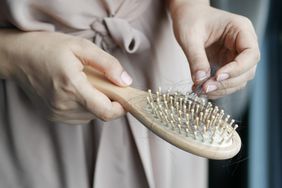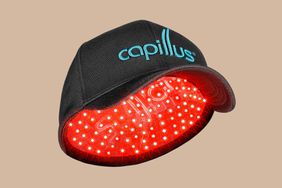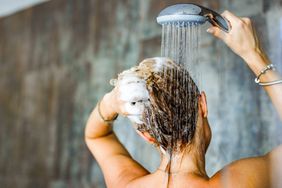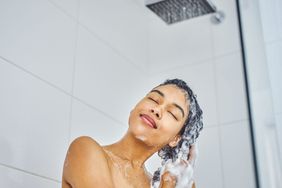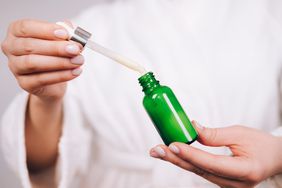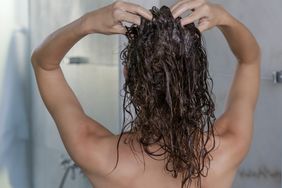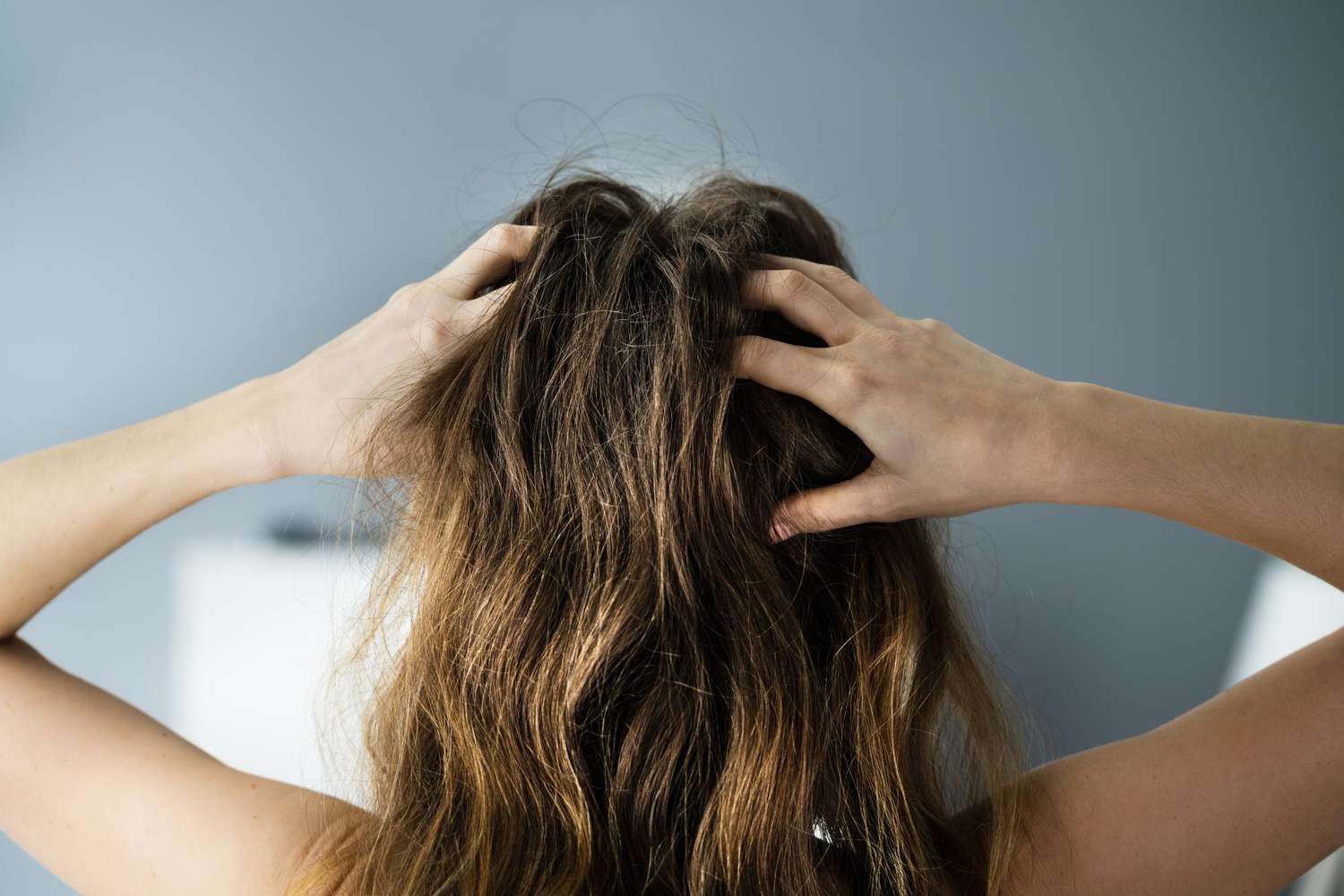
Your crown is the highest point of your head, and while it's not entirely clear why hair thins in this particular location, both men and women lose hair there, explains Kimberly Lee, MD, a facial plastic and reconstructive surgeon based in Beverly Hills. "Given its location, the crown is one of the hardest areas to visualize, so hair loss here is often overlooked and can progress for some time before [patients] seek help."
Ultimately, thinning at the crown can happen to anyone—but that doesn't make it less frustrating when it happens to you. If you pulled your hair up into a ponytail recently and noticed a thinner patch or pesky baby strands, you may be experiencing some hair loss in this area. If so, you're likely wondering what caused it—and how to prevent and treat hair thinning at the crown moving forward.
The Causes of Hair Thinning at the Crown
In women, hair thinning at the crown could be a sign of alopecia. Most commonly, there are two types of alopecia: androgenic (or hormonally-triggered hair loss) and alopecia areata (an autoimmune disease), says Deanne Mraz Robinson, MD, FAAD, the chief medical officer of Ideal Image. Hair loss in this region can also be associated with certain medications, medical conditions and—believe it or not—the hairstyle you choose to wear.
Hormonal Changes
According to Dr. Lee, the hair growth cycle has three phases: anagen (growing phase), catagen (transitional phase), and telogen (resting phase). "High levels of androgens, such as dihydrotestosterone (DHT), shorten the anagen cycle and shrink hair follicles, causing hair to grow thinner and more fragile. Hair falls out faster," she says, noting that the crown is often impacted. "DHT can also increase the time it takes for hair follicles to grow new hairs."
In other words, when your hormones go haywire, the rest of your body reacts. Polycystic ovary syndrome (PCOS) can also cause hormonally-induced hair loss at the crown; this occurs when your ovaries produce more male sex hormones (androgens) than usual. As for other hormonal causes? Many new mothers will experience some level of hair loss at the crown and temples during the postpartum period, usually peaking at four months.
Tight Ponytails or Buns
Though you may like sporting a high ponytail or bun, these styles might be doing some serious damage to your scalp's crown area. Too-tight looks might result in breakage and hair loss, something called traction alopecia. Luckily, this is very treatable, affirms Dr. Robinson. "If you switch up your style and are gentle on the affected hair, it will likely regrow and recover fully," she says.
It's important to also keep in mind that our hair is more vulnerable when wet, so it is best to manipulate it when it's dry, when stands have more elasticity and resiliency, Dr. Robinson adds.
How to Prevent Hair Thinning at the Crown
Though some medical conditions and seasons of life (including the postpartum period) make certain forms of hair loss inevitable, preventive measures can mitigate the severity. From diet and lifestyle changes to strategic styling choices, here's how to prevent hair thinning at the crown.
Regularly Shampoo Your Hair
Think of your scalp like your facial skin, says Kerry Yates, a trichologist at the Colour Collective. Would you ever go multiple days without washing your face? Probably not—especially if you knew you'd break out. However, many of us go a week without sudsing up our strands and turn to dry shampoo to camouflage the oil build-up. "Overuse of dry shampoos leads to clogged follicles, which, over time, can cause permanent damage—leading to hair loss [at the crown]," she says. "To prevent this from happening, try to wash your hair a minimum of every three to four days."
Avoid Hot Tools
Plenty of us blow dry and style our hair with heat—but it's no secret that hot tools damage our strands. If you're already noticing thinning at the crown (or short, broken hairs in this area), try removing heat from your styling routine, Dr. Lee recommends. Continuing will only put more stress on your already taxed strands, leading to more breakage.
Focus on Nutrition
Here's another reason to avoid short-term, fad diets: They deleteriously impact this particular part of your scalp (and your entire body in general), notes Yates. "Extreme dieting, like starting a cleanse, can wreak havoc on your hair," Yates says. "When you make such drastic changes, you are ultimately cutting out body-loving nutrients, which negatively impact your hair's life cycle."
Don't Scratch
If you struggle with an itchy scalp, you know how powerful the urge to scratch can be. Rather than succumbing to that urge, Yates recommends seeing a doctor as soon as possible to determine the cause of this inflammation or any flakiness. "Aggressive scratching on the scalp can inflame the skin there, damaging the hair follicle," she explains. "Prolonged scratching in the same area can create permanent scars, ultimately 'killing' the follicle. Solve the itch and save your hair."
Limit Hat Use
Yes, hats hide bed-head and protect your scalp from the sun and environmental stressors—but they also cause repetitive friction, especially if you wear one on consecutive days. "This type of friction can cause pulling, which can lead to inflammation of the follicle. Prolonged inflammation can lead to permanent damage, which leads to hair loss," Yates says. "Give hats a rest for a few days to protect your strands."
Manage Stress and Try Supplements
When you go through a heightened period of stress, you might notice many emotional and physical changes in your body, including hair thinning at the crown, Dr. Lee says. In addition to finding a way to manage your symptoms through therapy or exercise, she also recommends taking supplements. These include biotin, zinc, iron, and magnesium. "Ashwagandha, biocurcumin, saw palmetto, and collagen can also help promote hair growth and stability for the follicles," she says.
How to Treat Hair Thinning at the Crown
First things first: See your doctor or dermatologist if you're experiencing hair thinning at the crown to identify the root cause. Per Dr. Robinson, a medical professional can determine if the hair loss is scarring (permanent) or non-scarring (reversible). In many cases—especially the latter—your physician can recommend diet, supplement, and lifestyle changes that should alleviate your symptoms.
However, not all hope is lost if you are experiencing scarring hair loss at the crown. Dr. Lee notes that there have been significant advances in stimulating hair growth, including procedures involving PRP, pr platelet-rich plasma. For this treatment, blood is drawn from the patient into proprietary tubes in which the PRP is prepared. "The platelet-rich plasma is then concentrated, and only the PRP is re-injected into the scalp," she says. "To enhance PRP, exosomes or stem cell derivatives are injected separately to promote the PRP function for an enhanced and faster result."
